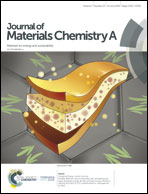A kinetically well-matched full-carbon sodium-ion capacitor†
Abstract
Sodium-ion capacitors (SICs), as new-generation electrochemical energy-storage systems, have combined the advantages of high energy and power densities, meeting the urgent demand for versatile electronic equipment and grid energy-storage stations. Nevertheless, the electrochemical performance of SICs is seriously restricted by the kinetic mismatch between the battery-type anode and capacitor-type cathode. In this work, N-doped 3D carbon (NHPC) delivered a high reversible specific capacity of 197 mA h g−1 at 2 A g−1, and the mechanism of its electrochemistry mainly involved strong pseudocapacitive storage that promoted quick physical adsorption/desorption. Moreover, further activation of NHPC yielded nitrogen-doped hierarchical porous activated carbon (NHPAC), which displayed a large specific surface area of 1478 m2 g−1 with abundant meso/macropores, and brought about fast adsorption/desorption of anions on its surface. The full-carbon SIC device benefitted from the similar material systems used for its anode and cathode, and hence achieved a high energy density of 115 W h kg−1 at 200 W kg−1 as well as long-term cyclability in the potential range of 0–4.0 V. This rational strategy of kinetic matching might open up a potential avenue for the development of additional advanced SICs.



 Please wait while we load your content...
Please wait while we load your content...